Land Use Changes in a Peri-Urban Area and Consequences on the Urban Heat Island
Abstract
:1. Introduction
- (1)
- Soil sealing reduces the vegetation cover and prevents the storage of rainwater and consequently the amount of water stored into the soil. Consequently, water available for evapotranspiration processes is much lower than in a natural surface. It follows that the latent heat dissipated from urban surfaces is close to zero and the amount of advanced energy will be available for other processes usually related to an increase of the thermal field [10].
- (2)
- Materials used for the buildings may, according to their specific thermal and optical properties, store energy and radiation in form of heat when the radiation budget (Rn) is positive and release energy when Rn is negative.
2. Materials and Methods
2.1. Energy Balance Method
- Q = Latent Heat Flux + Storage Heat Flux (W m−2)
- Dz = reference height (2 m)
- k = air thermal conductivity (0.026 W m−1 K−1 )
2.2. Fluidodynamic Simulation (Envi-Met): The Case Study
3. Results and Discussion
- -
- Speed and wind direction at 10 m: 1.4 m s−1, 90 °;
- -
- Surface roughness length (z0): 0.1 m;
- -
- Air temperature: 301.7 K
- -
- Specific humidity at 2500 m: 7 g water/kg air
- -
- Relative humidity at 2 m: 50%
4. Conclusions
Author Contributions
Funding
Acknowledgments
Conflicts of Interest
References
- World Urbanization Prospects: The 2018 Revision. Available online: https://population.un.org/wup/Publications/Files/WUP2018-KeyFacts.pdf (accessed on 13 November 2019).
- Grimmond, S. Urbanization and global environmental change: Local effects of urban warming. Geogr. J. 2007, 173, 83–88. [Google Scholar] [CrossRef]
- Chapman, A.; Watson, J.E.M.; Salazar, A.; Thatcher, M.; McAlpine, C.A. The impact of urbanization and climate change on urban temperature: A systematic review. Landsc. Ecol. 2017, 32, 1921–1935. [Google Scholar] [CrossRef]
- Lim, Y.K.; Cai, M.; Kalnay, E.; Zhou, L. Observational evidence of sensitivity of surface climate changes to land types and urbanization. Geophys. Res. Lett. 2006, 32, L22712. [Google Scholar] [CrossRef]
- Li, Y.; Zhao, M.; Motesharrei, S.; Mu, Q.; Kalnay, E.; Li, S. Local cooling and warming effects of forest based on satellite data. Nat. Commun. 2015, 6, 6603. [Google Scholar] [CrossRef] [PubMed]
- Oke, T.R. The surface energy budgets of urban area. In Modelling the Urban Boundary Layer; AMS: Boston, MA, USA, 1981. [Google Scholar]
- Fischer, E.M.; Seneviratne, S.I.; Vidale, P.L.; Lüthi, D.; Schär, C. Soil moisture-atmosphere interactions during the 2003 European summer heat wave. J. Clim. 2007, 20, 5081–5099. [Google Scholar] [CrossRef]
- Liu, Y. Introduction to land use and rural sustainability in China. Land Use Policy 2018, 74, 1–4. [Google Scholar] [CrossRef]
- Liu, Z.; Liu, Y.; Baig, M.H.A. Biophysical effect of conversion from croplands to grasslands in water-limited temperate regions of China. Sci. Total Environ. 2019, 648, 315–324. [Google Scholar] [CrossRef] [PubMed]
- Moulai, M.; Khavari, F.; Shahhosseini, G.; Zanjani, N.E. A study of the urban heat island mitigation strategies: The case of two cities. Int. J. Urban Manag. Energy Sustain. 2017, 1, 1–7. [Google Scholar]
- Memon, R.A.; Leung, D.Y.C.; Chunho, L. A review on the generation, determination and mitigation of Urban Heat Island. J. Environ. Sci. 2008, 20, 120–127. [Google Scholar]
- Stull, R.B. An Introduction to Boundary Layer Meteorology; Kluwer Academic Publishers: Dordrecht, The Netherlands, 1988; p. 666. [Google Scholar]
- Hargreaves, G.H.; Samani, Z.A. Estimating potential evapotranspiration. Tech. Note J. Irrig. Drain. Eng. 1982, 18, 980–984. [Google Scholar]
- Allen, R.G.; Pereira, L.S.; Raes, D.; Smith, M. Crop Evapotranspiration (Guidelines for Computing Crop Water Requirements). In FAO Irrigation and Drainage Paper No. 56; FAO: Rome, Italy, 1998. [Google Scholar]
- Bruse, M.; Fleer, H. Simulating surface-plant-air interactions inside urban environments with a three dimensional numerical model. Environ. Model. Softw. 1998, 13, 372–384. [Google Scholar] [CrossRef]
- ENVI-Met Software Home Page. Available online: http://www.envi-met.com/ (accessed on 13 November 2019).
- Yang, X.; Zhao, L.; Bruse, M.; Meng, Q. Evaluation of a microclimate model for predicting the thermal behaviour of different ground surfaces. Build. Environ. 2013, 60, 93–104. [Google Scholar] [CrossRef]
- Giridharan, R.; Lau, S.S.Y.; Ganesan, S. Nocturnal heat island effect in urban residential developments of Hong Kong. Energy Build. 2005, 37, 964–971. [Google Scholar] [CrossRef]
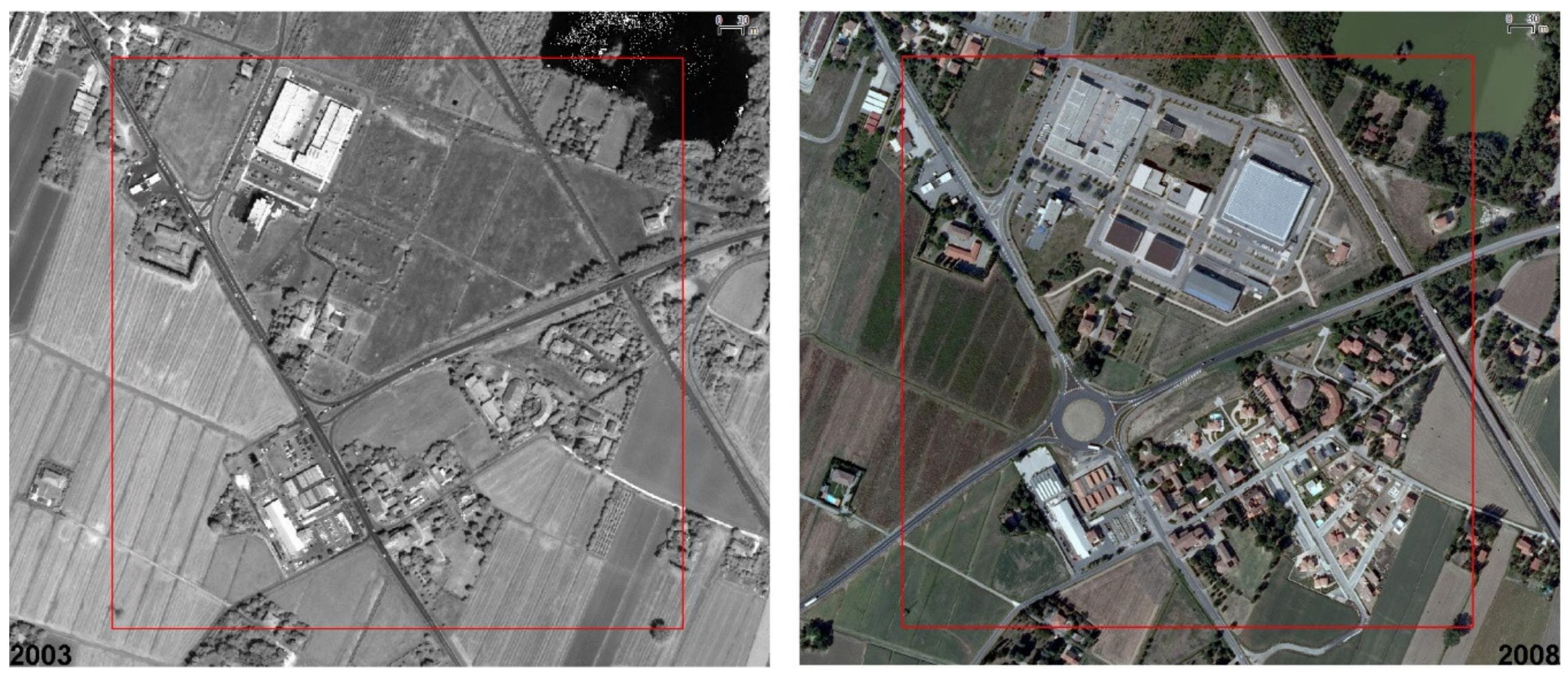
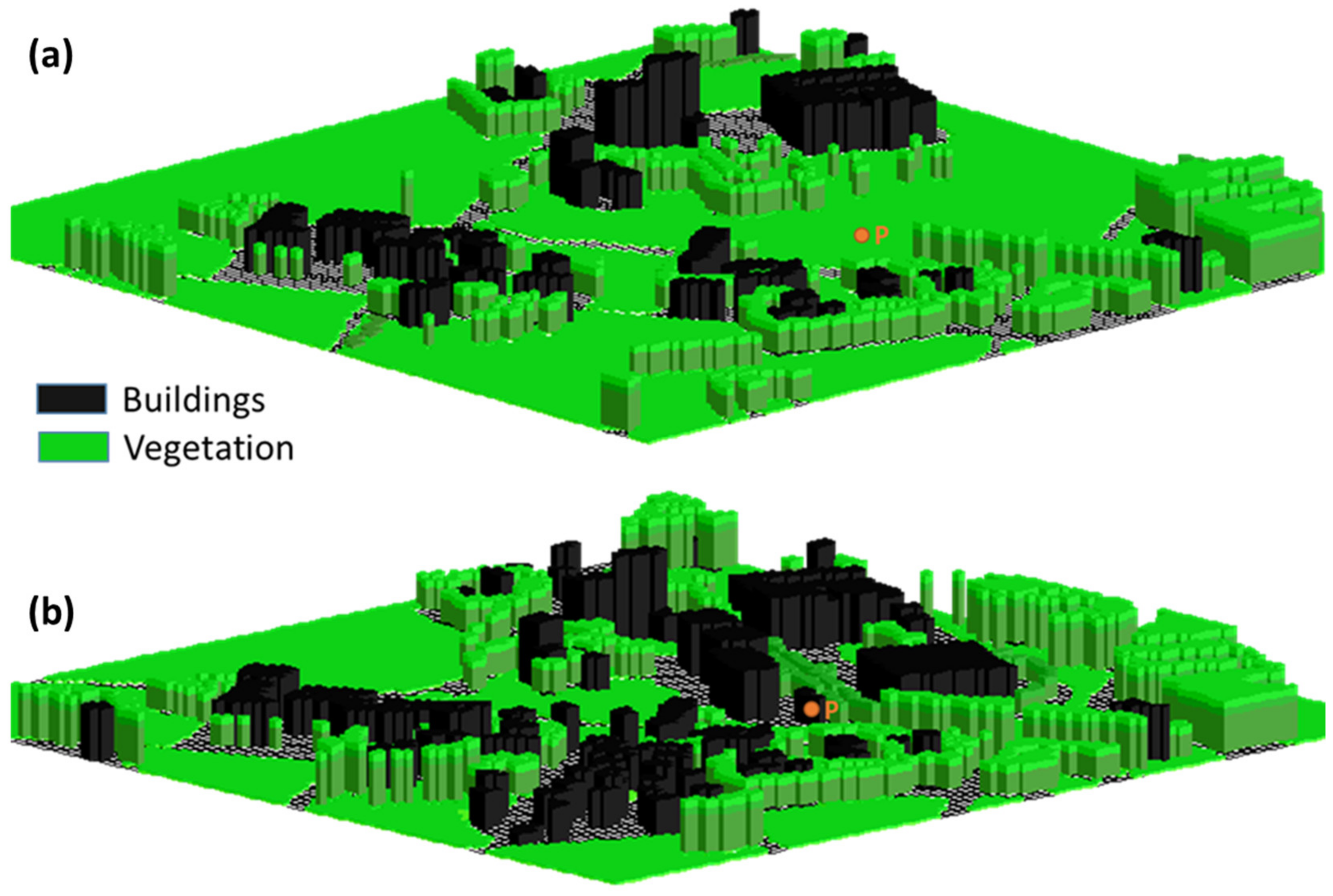
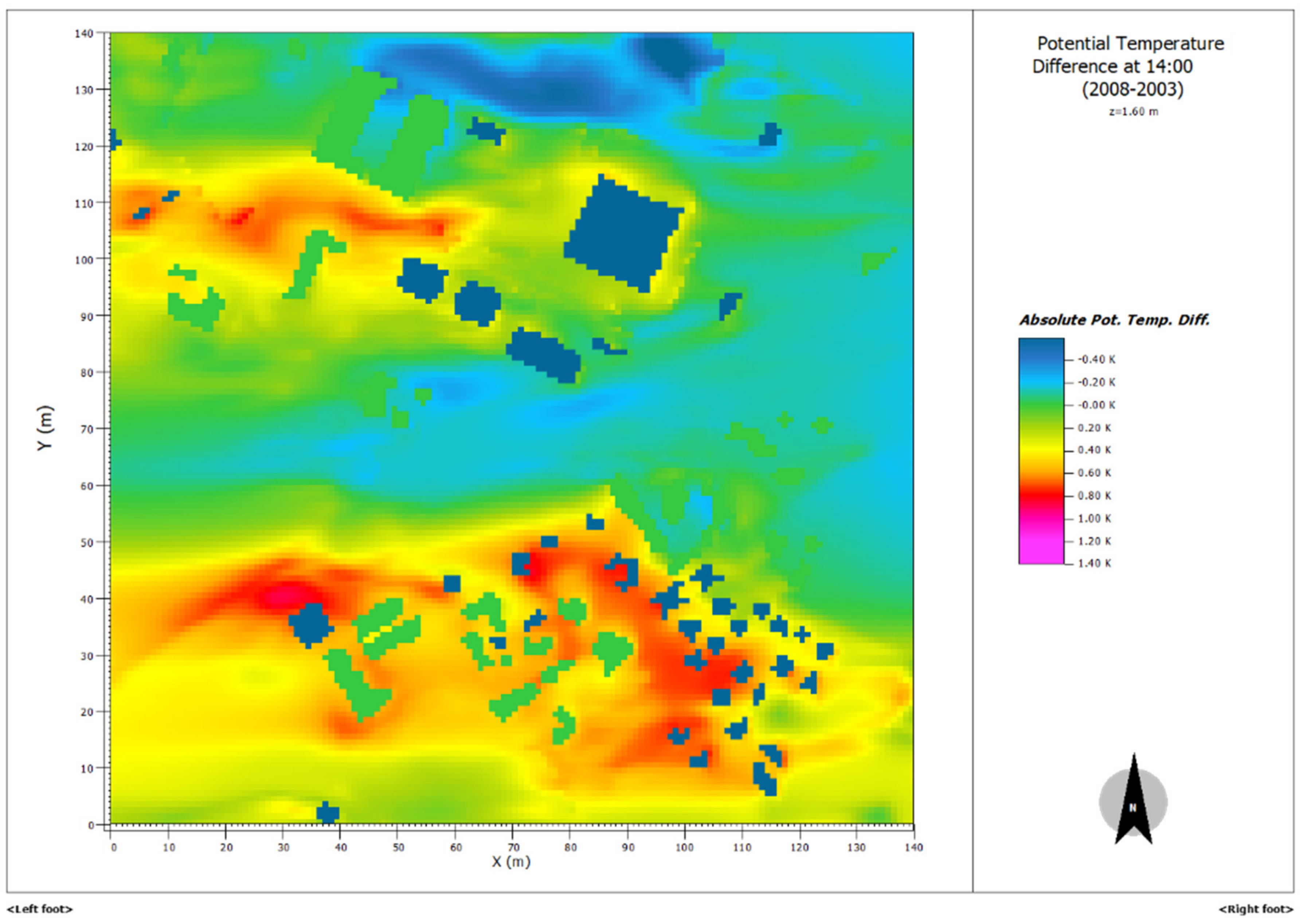
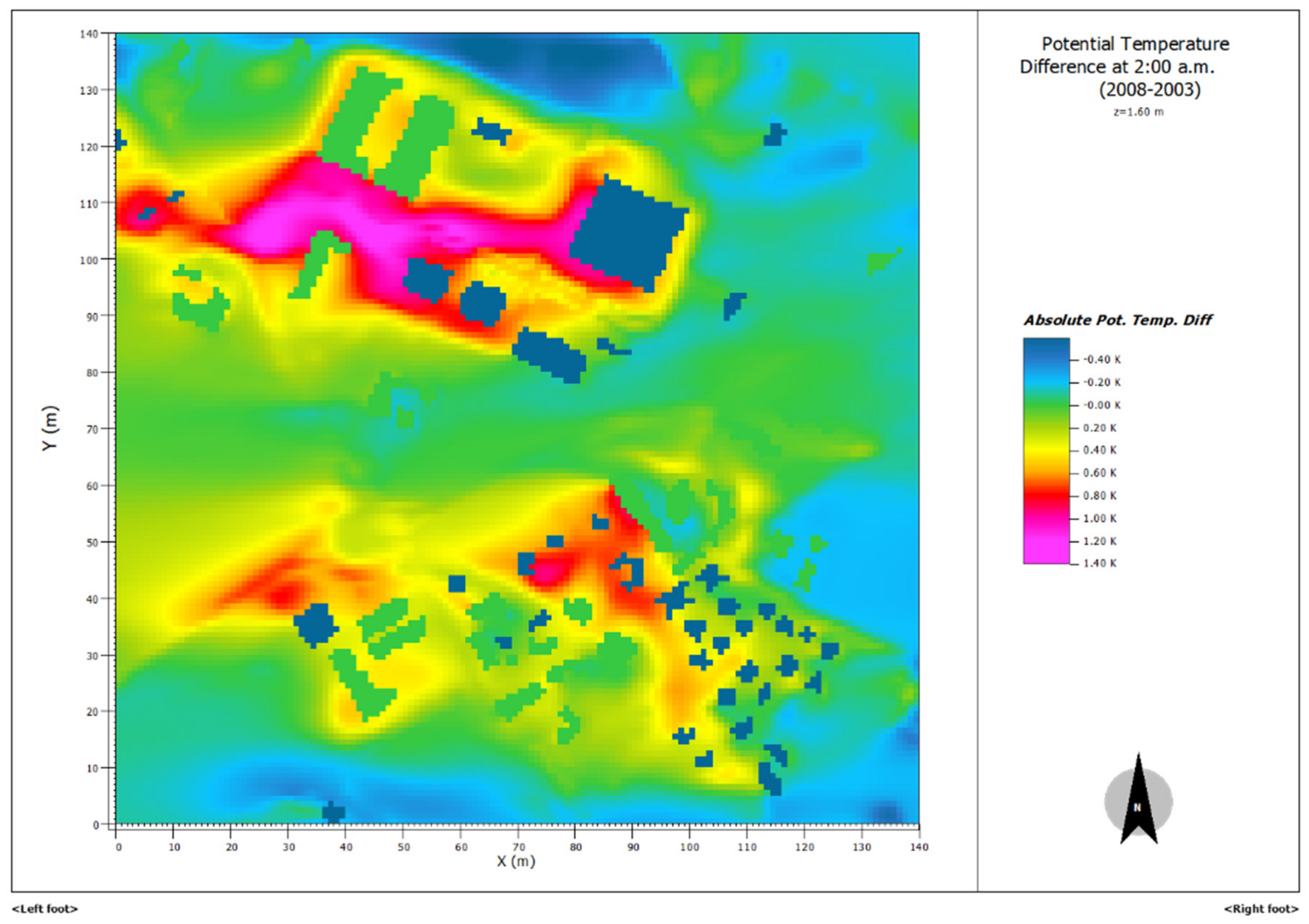
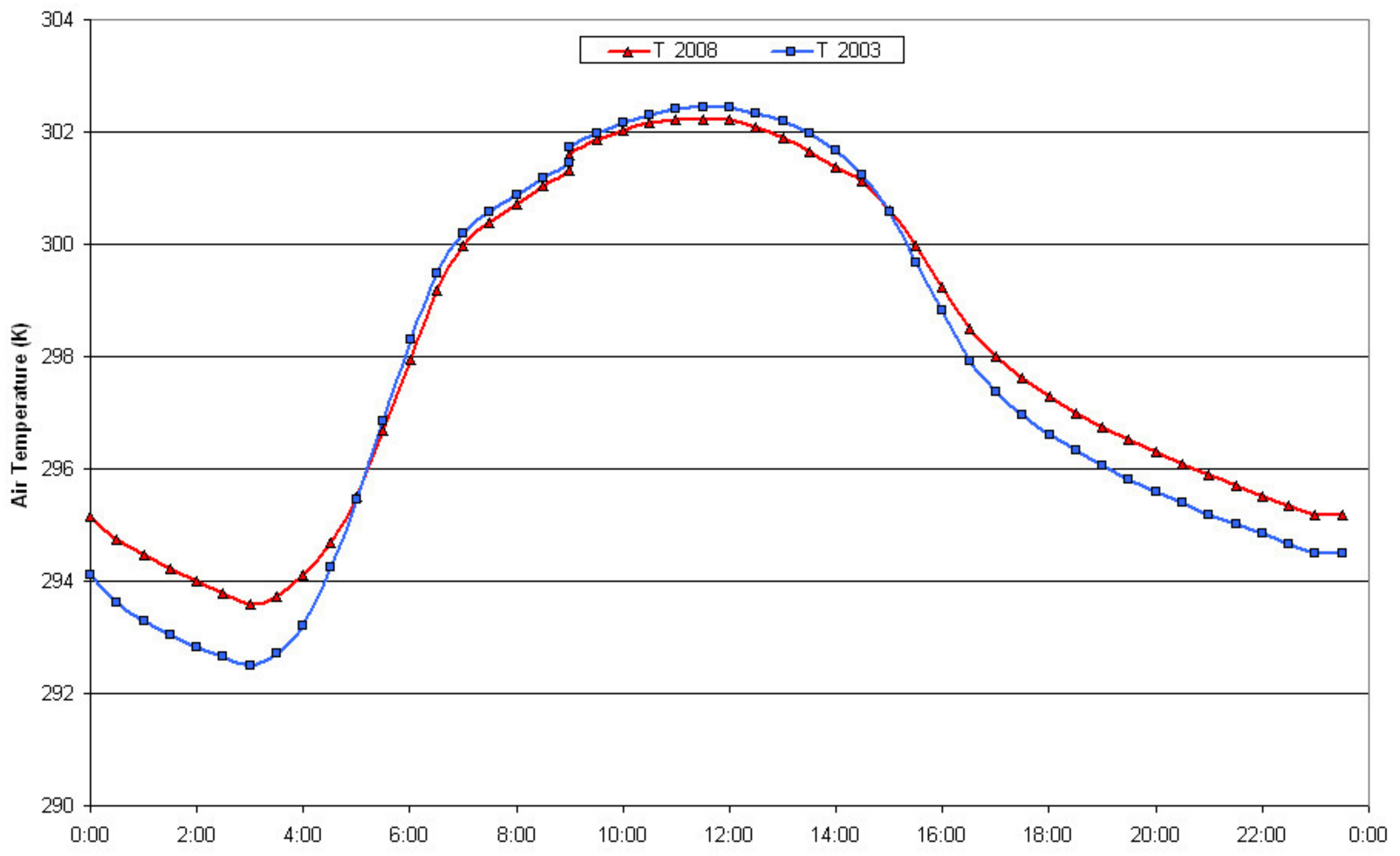
| Station | Swin (W m−2) | Swout (W m−2) | Lwin (W m−2) | Lwout (W m−2) |
|---|---|---|---|---|
| Bologna urban | 148 | 26 | 325 | 396 |
| San Pietro Capofiume | 156 | 27 | 305 | 361 |
| Nocturnal Rn (W m−2) | Diurnal Rn (W m−2) | |||
|---|---|---|---|---|
| Month | San P. Capof. | Bologna Urban | San P. Capof. | Bologna Urban |
| January | −17 | −39 | 78 | 52 |
| February | −31 | −57 | 138 | 124 |
| March | −34 | −63 | 253 | 201 |
| April | −28 | −62 | 246 | 278 |
| May | −24 | −52 | 288 | 280 |
| June | −36 | −60 | 287 | 285 |
| July | −51 | −71 | 279 | 293 |
| August | −39 | −67 | 255 | 239 |
| September | −28 | −62 | 198 | 189 |
| October | −26 | −55 | 157 | 141 |
| November | −18 | −44 | 77 | 71 |
| December | −19 | −47 | 68 | 48 |
| Month | ET0 (mm) | Kc (Wheat and Spon. Grass) | ETc (mm) | Latent Heat Flux (W m−2) |
|---|---|---|---|---|
| January | 19.8 | 0.4 | 7.9 | 6.9 |
| February | 36.3 | 0.5 | 18.2 | 17.4 |
| March | 66.9 | 0.7 | 46.8 | 40.8 |
| April | 109.1 | 0.9 | 98.2 | 88.4 |
| May | 153.1 | 1.1 | 168.4 | 146.7 |
| June | 178.4 | 1.0 | 178.4 | 160.7 |
| July | 204.0 | 0.2 | 40.8 | 35.6 |
| August | 166.1 | 0.3 | 49.8 | 43.4 |
| September | 110.8 | 0.5 | 55.4 | 49.9 |
| October | 64.3 | 0.4 | 25.7 | 22.4 |
| November | 31.0 | 0.4 | 12.4 | 11.2 |
| December | 19.1 | 0.4 | 7.7 | 6.7 |
| Diurnal Qs (W m−2) | Nocturnal Qs (W m−2) | |||||
|---|---|---|---|---|---|---|
| Month | 2003 | 2008 | Difference | 2003 | 2008 | Difference |
| January | 23.4 | 23.1 | −0.3 | −10.1 | −15.2 | −5.1 |
| February | 37.9 | 42.4 | 4.4 | −18.1 | −25.1 | −7.0 |
| March | 66.0 | 62.9 | −3.2 | −20.0 | −27.8 | −7.8 |
| April | 64.5 | 83.6 | 19.2 | −16.6 | −24.6 | −8.0 |
| May | 74.7 | 84.0 | 9.3 | −14.5 | −21.1 | −6.6 |
| June | 74.3 | 85.4 | 11.1 | −20.6 | −27.8 | −7.1 |
| July | 72.6 | 87.5 | 14.9 | −29.4 | −37.1 | −7.7 |
| August | 66.7 | 73.0 | 6.3 | −22.5 | −30.6 | −8.1 |
| September | 52.7 | 59.9 | 7.2 | −16.6 | −24.6 | −8.0 |
| October | 42.5 | 46.9 | 4.4 | −15.3 | −22.3 | −7.0 |
| November | 22.9 | 28.3 | 5.4 | −10.9 | −16.6 | −5.8 |
| December | 20.8 | 22.1 | 1.3 | −11.7 | −17.8 | −6.2 |
| Month | Δ LE + Diurnal Δ Qs (W m−2) | ΔT day (°C) | ΔT night (°C) | ΔT mean (°C) |
|---|---|---|---|---|
| January | 2.1 | 0.11 | 0.27 | 0.19 |
| Febrary | 0.1 | 0.00 | 0.37 | 0.19 |
| March | 13.7 | 0.71 | 0.41 | 0.56 |
| April | 3.8 | 0.20 | 0.42 | 0.31 |
| May | 28.7 | 1.49 | 0.34 | 0.92 |
| June | 30.6 | 1.59 | 0.37 | 0.98 |
| July | −5.7 | −0.29 | 0.40 | 0.05 |
| August | 5.0 | 0.26 | 0.42 | 0.34 |
| September | 5.7 | 0.30 | 0.42 | 0.36 |
| October | 1.4 | 0.07 | 0.36 | 0.22 |
| November | −2.5 | −0.13 | 0.30 | 0.09 |
| December | 0.4 | 0.02 | 0.32 | 0.17 |
© 2019 by the authors. Licensee MDPI, Basel, Switzerland. This article is an open access article distributed under the terms and conditions of the Creative Commons Attribution (CC BY) license (http://creativecommons.org/licenses/by/4.0/).
Share and Cite
Nardino, M.; Laruccia, N. Land Use Changes in a Peri-Urban Area and Consequences on the Urban Heat Island. Climate 2019, 7, 133. https://doi.org/10.3390/cli7110133
Nardino M, Laruccia N. Land Use Changes in a Peri-Urban Area and Consequences on the Urban Heat Island. Climate. 2019; 7(11):133. https://doi.org/10.3390/cli7110133
Chicago/Turabian StyleNardino, Marianna, and Nicola Laruccia. 2019. "Land Use Changes in a Peri-Urban Area and Consequences on the Urban Heat Island" Climate 7, no. 11: 133. https://doi.org/10.3390/cli7110133
APA StyleNardino, M., & Laruccia, N. (2019). Land Use Changes in a Peri-Urban Area and Consequences on the Urban Heat Island. Climate, 7(11), 133. https://doi.org/10.3390/cli7110133






